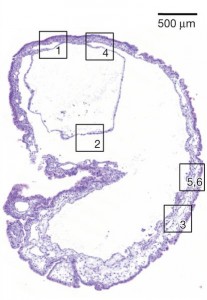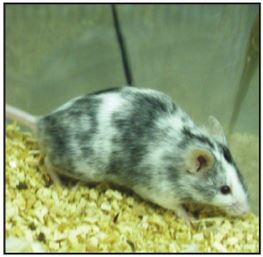Stem Cell Breakthrough
Subject Areas: Cell Biology, Stem Cells, Developmental Biology
Vocabulary:
Pluripotent – in cell biology, a pluripotent cell is one that can give rise to more than one cell type. When most adult cells proliferate, they divide in two through mitosis, yielding two essentially identical cells. A pluripotent cell on the other hand, can produce two dissimilar daughter cells, at least one of which is also able to produce other types of cells.
Totipotent – a totipotent cell is a type of pluripotent cell that can give rise to any cell type found in the body. This usually only happens at the very early stages of development. A newly fertilized egg is totipotent, as are the initial ball/lump of cells that come from its first divisions.
Differentiation – the process by which a pluripotent cell becomes a specialized cell that is either unable to produce daughter cells, or is only able to produce daughter cells that are just like itself. These differentiated cells may have specific shapes or structures in order to carry out specific tasks, such as the long axons of nerve cells, or the microvilli of intestinal lining cells. Differentiation mostly occurs by shutting down access to parts of the cell’s DNA that it does not need for its specific function.
The Article:
Abad, M. et al. Reprogramming in vivo produces teratomas and iPS cells with totipotency features. Nature (2013). doi: 10.1038/nature12586
The Idea
Stem cells (essentially a common name for pluripotent cells) have been an important, if sometimes controversial, avenue of biomedical investigation for the last two decades. Their medical promise is nearly endless: the idea is that because stem cells are pluripotent, if we can figure out how to control their differentiation in specific cell types, we could potentially have a way of replacing any kind of diseased cells with good ones. Adult mammals are comprised of mostly fully differentiated cells, but there are some stem cells in adults, mostly in the bone marrow, where they give rise to different kinds of blood cells.
For a long time, it was thought that the only source of totipotent stem cells was the embryo. However, because there is considerable political controversy over the use of embryonic stem cells, there has been a search for other totipotent stem cells or a way to create them. Research in the last few years has demonstrated the ability to create stem cells from differentiated cells (such as adipocytes, or fat cells). Some appear to be able to generate a wide range of cell types, but it is difficult to actually prove totipotency. The techniques used to create these “induced pluripotent stem cells” or iPSCs, have always been done in a culture dish, and not inside a living animal. The assumption has been that there are too many chemical signals in the body of the animal that cause differentiation, so it would always be working against trying to de-differentiate cells.
New research has shown that it is possible to “reprogram” or re-differentiate one cell type into another in vivo, so the authors decided to go a step further and see if they could generate pluripotent stem cells in a living animal (mouse).
What They Did
Investigators at the Spanish National Cancer Research Center created transgenic mice (mice whose genes have been directly manipulated) that have inserted in their genome a stretch of DNA that encodes four different factors (Oct4, Sox2, Klf4, c-Myc) that together are known to help induce pluripotency in vitro. They also made the production of these factors switchable by including a doxycycline inducer in the DNA sequence. Doxycycline is a common antibiotic, and at the concentrations used was not expected to harm the mice. The way the inserted genes work is that when the mice are not given doxycycline, they develop and live normally, and the four factors are not abnormally expressed. But when they are given doxycycline in their drinking water, production of those four dedifferentiation factors is turned on.
It turns out that when they did this at first with a two-week treatment, many of the mice lost a lot of weight and died. Examining the dead mice, they found major changes in many tissues, especially in the intestine (which may explain the weight loss) and pancreas. With that information, they modified their experiment and induced the mice with either a lower dose, or with the high dose, but for only one week. Many of these died as well, but after a longer time (varied, ~2-10 weeks). Examination of the bodies showed a large number of tumors, many of which were teratomas. Teratomas are tumors that come from pluripotent cells that proliferate and differentiate in a random mess.
Cool Results
One of the first things they looked for and found was the presence of iPSCs in the bloodstream. These in vivo stem cells had more similarities to embryonic stem cells (the gold standard) than stem cells created in vitro. This suggests this could be a useful technique for maintaing a steady source of mouse stem cells to work with.
The more astounding thing they found was that some of the abnormal structures in a couple (out of 77 total) of the mice examined actually resembled embryos.
Even more amazing, when they inject these in vivo-produced stem cells into a normal mouse, it created something that resembled an embryo! First background: if you inject stem cells created in vitro or even normal embryonic stem cells into the abdominal (intraperitoneal, to be more specific) cavity, they pretty much just form tumors. So the fact that these cells formed layered, embryo-like structures as well as tissue that resembled placenta and yolk sac, actually suggests that these cells may actually be closer to full totipotency than even embryonic stem cells.

This structure has many characteristics like an embryo, but it started as a mass of in vivo-produced stem cells injected into abdomical cavity of a normal mouse. from Abad et al.



No comments
Be the first one to leave a comment.